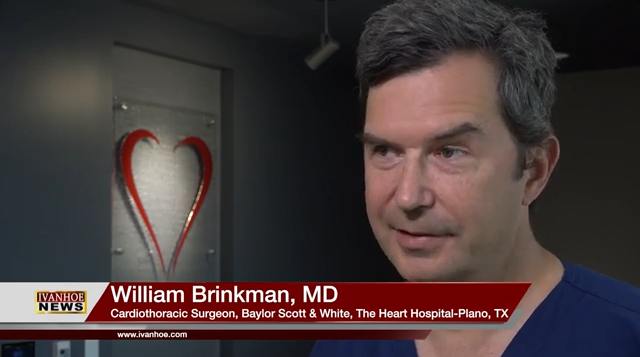Cardiothoracic surgeon at Baylor Scott & White with The Heart Hospital in Plano, Texas, Dr. William Brinkman talks about a new procedure to save cardiovascular disease patients.
Interview conducted by Ivanhoe Broadcast News in 2023.
What is the Ross procedure and what is it intending to do?
BRINKMAN: The Ross procedure is a form of aortic valve replacement where we use your own native tissue, specifically your pulmonary valve and we move it into where your aortic valve was. It’s a procedure used for younger patients with aortic valve disease and specifically aortic valve problems that can’t be repaired. Also, patients that don’t want to be on blood thinners with a mechanical valve.
Is this procedure particularly for those who may be in what we consider the early stages of heart failure?
BRINKMAN: We usually like to do this procedure before patients are in heart failure rate. Yes, many times they’re in mild or moderate heart failure when we decide to do this procedure.
How is the surgery done?
BRINKMAN: The Ross procedure is an open heart surgery procedure. Involves an incision on the chest, not a large one, but it does involve an incision on the chest called a sternotomy. We’re basically taking your pulmonary valve and moving it over to where the aortic valve was. The beauty of the Ross procedure it’s the only aortic valve replacement where you have your own living tissue still functioning as a valve. It’s the only valve replacement where the leaflets were actually designed by nature to function as leaflets. The way the blood flows through the valve and the gradients across the valve. It’s been shown that it’s very good for the long-term function of the heart in the long-term survival of the patient. It is a complex procedure which is one of the downsides of the Ross procedure. It’s a two valves solution for a one-valve problem. That takes a surgeon in the center with a focus to really deliver the quality outcomes that a Ross procedure can give.
How old is the recipe? How long has it been approved for treatment?
BRINKMAN: Well, Donald Ross first did it in the early ’60s and it was designed as they were desperate for alternatives for aortic valve replacements. Especially in younger patients or particularly young female patients who needed a valve replacement and didn’t want to be on Coumadin, wanted to have children, and being on Coumadin during pregnancy is very difficult. That’s the origin of the Ross procedure, and then doctors realized that the gradients in the blood flow across the Ross are superior to the cow, the pig valves and the mechanical valves in terms of the gradients, meaning the-the work the heart has to do to pump the blood. We also noticed in the past few years looking at the long-term survival of patients with a Ross procedure, that it’s superior. It’s the only valve replacement with long-term survival that parallels the survival of the average American population, which is remarkable. The downside of the Ross procedure is that it’s complex. It requires a surgeon who with a focus on that area and the chance of a reoperation with the Ross procedure is slightly higher than with a mechanical valve. The benefits or the risk of embolic stroke are clots forming on the valve are lower. There are some trade-offs, but it’s an excellent long-term option. The 2022 Cardiology guidelines recently gave a recommendation that it’s a very reasonable option in patients less than 50 if done at a center with experience- with an experienced surgeon.
Can you restate that last part where you said the recommendation?
BRINKMAN: The American College of Cardiology recommendations recently confirmed that in patients under the age of 50, if done at an experienced center, the Ross is an excellent long-term option. The options for aortic valve replacement are mechanical valve, which requires Coumadin. The downside of that is there’s a slight bleeding risk over the course of your life. Most people tolerate it well, so it’s a very reasonable option. The Ross procedure offers a long-term- potentially long-term aortic valve solution without needing to be on Coumadin. Replacing the aortic valve of the cow-based valve or a pig base valve which you may have heard of, doesn’t require Coumadin, but those valves tend to wear out in about 10 to 15 years, so that’s a guaranteed re-operation. There are pluses and minuses to all of these things. The beauty of the Ross procedure is you have a potentially long-term solution, which is good for younger patients less than 50 who don’t need to be on Coumadin.
You have a lot of Ross procedures. She fit into that moreover, she wasn’t pregnant when that procedure happened?
BRINKMAN: Yes, Stacy fits into the Ross category perfectly because she’s a young, active female who doesn’t want to be on any coagulation. She wants to live a long time. I think the mechanical valve would have been a reasonable option, but the Ross was a little bit better for her. The reasons also were anatomic, the fact that she had a primarily stenotic valve, meaning a valve that didn’t open well, we know those do very well with Ross procedures and she had that. The size of her pulmonary valve fits very nicely into where her aortic valve was. There are certain anatomic reasons why we would shy away from a Ross. She didn’t have those.
Tell us what her recovery has been like, you’ve probably seen her maybe a few times since then, what’s the difference between before and after for someone who wants to know what it looks like after that procedure?
BRINKMAN: Yeah. You’d have to ask her in detail, but I tell you that it’s a very satisfying procedure for me as a surgeon to be involved with. You get these patients who get short of breath, walking up a flight of steps and then within two months afterward, they’re really back to normal. Or they may have thought they weren’t that impeded and then it’s kind of like being in a dark room for many years and then you come outside in the light, and you don’t realize how much energy you can actually have. I think you’d need to talk to her, but I think we’ve seen her in routine follow-up for the past few years and she’s doing great.
That’s exactly what she told me, she noticed that she was out of breath doing the simplest things. That she began to think that that was normal for her. Is that a common thing that you hear from patients?
BRINKMAN: Yes, frequently it’s watching grass grow or a glacier move. It’s so slow and insidious, you don’t even notice it. You just think this is the way life is as good as it gets. But then we look at the echo, we realize how much extra work the heart muscle is doing. It’s almost like unleashing a horse that’s been chained down or something. The horse is fine. It has great legs and wants to run. We have chained down, you unchain it and that horse runs and it’s great. It’s a great feeling for the patients.
How does one know? Because I know people who say I just feel like I’m out of breath. I feel like I don’t have enough energy. Is that kind of a sign and symptom that maybe you should really get your heart checked out? Then is that again an echo that you mentioned before?
BRINKMAN: Her particular problem with aortic stenosis, is the doctor’s talk for a valve that’s stiff and doesn’t open. That can cause fatigue and shortness of breath and inability to exert yourself. IF you have these symptoms, you to need to just meet with your primary care doctor and maybe get a cardiac echo. The echo will show how your cardiac valve are working. If you do have aortic stenosis, aortic valve replacement is the option. In Stacy’s situation, Ross was a good option. But there are other options for replacement too. Such as a mechanical valve or a cow or a pig valve. In a patient over 65, we generally wouldn’t do Ross’s procedure because the cow and the pig valves work very well. It’s these younger patients who need to be on Coumadin for many years that benefit from the Ross procedure.
END OF INTERVIEW
This information is intended for additional research purposes only. It is not to be used as a prescription or advice from Ivanhoe Broadcast News, Inc. or any medical professional interviewed. Ivanhoe Broadcast News, Inc. assumes no responsibility for the depth or accuracy of physician statements. Procedures or medicines apply to different people and medical factors; always consult your physician on medical matters.
If you would like more information, please contact:
Deke Jones
Sign up for a free weekly e-mail on Medical Breakthroughs called First to Know by clicking here




